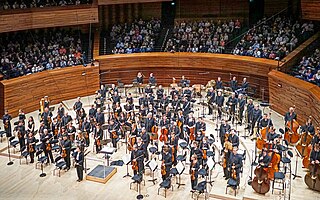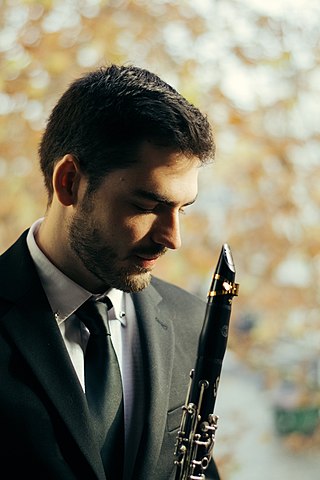
Symphony Hall is a 2,262 seat concert venue in Birmingham, England. It was officially opened by Queen Elizabeth II on 12 June 1991, although it had been in use since 15 April 1991. It is home to the City of Birmingham Symphony Orchestra and hosts around 270 events a year. It was completed at a cost of £30 million. The hall's interior is modelled on the Musikverein in Vienna and the Concertgebouw in Amsterdam. The venue, managed alongside Town Hall, presents a programme of jazz, world, folk, rock, pop and classical concerts, organ recitals, spoken word, dance, comedy, educational and community performances, and is also used for conferences and business events as part of the International Convention Centre.

The Royal Festival Hall is a 2,700-seat concert, dance and talks venue within Southbank Centre in London, England. It is situated on the South Bank of the River Thames, not far from Hungerford Bridge, in the London Borough of Lambeth. It is a Grade I listed building, the first post-war building to become so protected. The London Philharmonic Orchestra, the Philharmonia Orchestra, the Orchestra of the Age of Enlightenment, the London Sinfonietta, Chineke! and Aurora are resident orchestras at Southbank Centre.
Radio France is the French national public radio broadcaster.

The Théâtre des Champs-Élysées is an entertainment venue standing at 15 avenue Montaigne in Paris. It is situated near Avenue des Champs-Élysées, from which it takes its name. Its eponymous main hall may seat up to 1,905 people, while the smaller Comédie and Studio des Champs-Élysées above the latter may seat 601 and 230 people respectively.

The Orchestre National de France is a French symphony orchestra based in Paris, founded in 1934. Placed under the administration of the French national radio, the ONF performs mainly in the Grand Auditorium at the Maison de la Radio et de la Musique from where all its concerts are broadcast. Some concerts are also held in the Théâtre des Champs-Élysées, which was the previous main venue of the orchestra before the Auditorium was built.
Esteban Benzecry is an Argentine classical composer.

John Wilton Nelson is an American conductor. His parents were Protestant missionaries.

The Orchestre Philharmonique de Radio France is a French radio orchestra, affiliated with Radio France. The orchestra performs principally at the auditorium of the Maison de la Radio in Paris, along with several concerts at the Philharmonie de Paris.

The Philharmonie de Paris is a complex of concert halls in Paris, France. The buildings also house exhibition spaces and rehearsal rooms. The main buildings are all located in the Parc de la Villette at the northeastern edge of Paris in the 19th arrondissement. At the core of this set of spaces is the symphonic concert hall of 2,400 seats designed by Jean Nouvel and opened in January 2015. Its construction had been postponed for about twenty years to complete the current musical institution la Cité de la Musique designed by Christian de Portzamparc and opened in 1995. Mainly dedicated to symphonic concerts, the Philharmonie de Paris also present other forms of music such as jazz and world music.

Raphaël Sévère born 15 September 1994 in Rennes, is a French clarinettist and composer.

Romain Hervé is a French classical pianist.

Vanessa Benelli Mosell is an Italian pianist and conductor.

Music in the city of Paris, France, includes a variety of genres, from opera and symphonic music to musical theater, jazz, rock, rap, hip-hop, the traditional Bal-musette and gypsy jazz, and every variety of world music, particularly music from Africa and North Africa. such as the Algerian-born music known as Raï. Leading musical institutions include the Paris Opera, the Orchestre de Paris, and the Paris Conservatory, the first state music conservatory in Europe. The Cité de la Musique at La Villette is home of the new Paris Symphony Hall, the Conservatory, a museum of musical instruments, and Le Zenith, a major venue for popular music. Many of the churches in Paris have magnificent historic organs, and often host concerts. The city is also known for its music halls and clubs.
Ducks Scéno is a French company based in Villeurbanne specializing in scenography and museography.

Maison de la Radio et de la Musique, nicknamed “maison ronde” is the headquarters of Radio France. It is located in the 16th arrondissement of Paris near the Eiffel Tower. Built in the shape of huge ring 500 meters in circumference, with a central utility tower, the building houses the administrative offices, broadcasting studios, and performance spaces for all of Radio France's national stations and its four permanent ensembles—Orchestre philharmonique de Radio France, Orchestre national de France, Chœur de Radio France and Maîtrise de Radio France. The building was designed by Henry Bernard and completed in 1963. It underwent a major renovation beginning in 2005 and began reopening to the public in 2014 with the inauguration of its new auditorium.
Denis Comtet is a French organist, pianist, choral conductor, and conductor.
Nathalia Milstein is a French classical pianist.
David Chaillou is a French composer, born in 1971.

The Salle Gaveau, named after the French piano maker Gaveau, is a classical concert hall in Paris, located at 45-47 rue La Boétie, in the 8th arrondissement of Paris. It is particularly intended for chamber music.
The Organ of the Trocadero Palace was built by Aristide Cavaillé-Coll for the 1878 Universal Exhibition at the Palais du Trocadéro in Paris, France. The organ was transferred to the Palais de Chaillot in 1937, before moving to the Auditorium Maurice-Ravel in Lyon in 1977.













